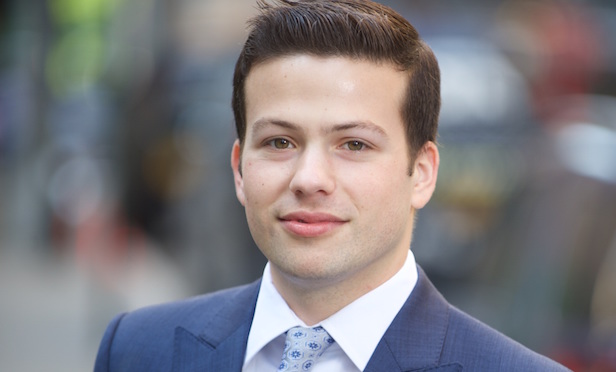
NEW YORK CITY—The Real Estate Board of New York held its bi-annual Spring Members' Luncheon where panelists discussed trends in seeking value, on Monday at the New York Hilton Midtown.
Evan Fiddle, vice president at CBRE, received REBNY's “2017 Most Promising Commercial Salesperson Award.” Candidates must be current REBNY members with less than five years of industry experience. The award recognizes leadership, team work, moral character, ethical professionalism and significant professional accomplishments.
Fiddle joined CBRE in October 2013 and represents tenants and owners, many Fortune 500 companies, private equity firms and hedge funds. He has handled major transactions, such as ones involving the following clients: MDC Partners with its disposition of 60,000 square feet at 909 Third Ave. and 650 Fifth Ave.; and Bank of China, the owner of 7 Bryant Park, in a 73,000 square-foot lease to Schroders Investment Management.

As part of the award, Fiddle will be granted a one-year term on REBNY's commercial brokerage board of directors and a one-year seat on REBNY's board of governors.
A group of expert panelists then shared their CRE insights to approximately 500 attendees at the event. Bruce Mosler, chairman of global brokerage, Cushman & Wakefield, moderated the discussion. He asked how new developments will affect the city's CRE marketplace. Could they possibly create an oversupply?
The average age of inventory for Class A buildings is 75 years, “That's unbelievable,” said Ric Clark, senior managing partner and chairman, Brookfield Property Group and Brookfield Property Partners. “We're active around the world and there's nothing like that anywhere.” Clark pointed out with the more than 12.5 million square feet of new development, it is two-thirds leased. He believes the current pipeline of office spaces will not adversely affect the health of the industry.
However, Clark said if each of the buildings at Hudson Yards gets an anchor tenant and goes forward at the same time, maybe that would create a different scenario. “But for now, I think this is a healthy amount of development in the market that really needs it.”
Isaac Zion, co-chief investment officer, SL Green Realty Corp., pointed out new construction is getting premium rents. In evaluating whether the economy could absorb the new office developments, Zion pointed to the square footage of new construction, the rate of construction, the space leased, the space not leased, the space vacated by relocating tenants, the space sold, and subtracted square feet for conversions of offices to residences and hotels.
He concluded the city would need between 10,000 to 12,000 new jobs a year for five years to absorb the new office space developed. “The city has done three times that over the past seven or eight years and for the next two the city projects it will be double that,” said Zion. “So there's not going to be a glut.”
Zion described Hudson Yards as being a great product, transit-oriented, and emphasized the vast overall size of New York City's office market. The New York state comptroller reported in 2016 there were 550 million square feet of office space in New York City.
Laurie Golub, COO, Square Mile Capital Management, pointed to JP Morgan Chase's plans to tear down and rebuild its headquarters at 270 Park Ave. “It's a market in desperate need of attention with a lot of aging buildings. It sits on one of the top transportation hubs of the city so it's natural that you'd see development there with the rezoning,” she said. “You take the first big bold step and hopefully we'll see more of it in the city.”
Mosler agreed, saying post-One Vanderbilt, this was the biggest news of what would positively affect the marketplace in Midtown. He then asked other than the big developments, what else was on the forefront?
“All this development has hit a nuclear arms race when it comes to redeveloping existing buildings,” said Clark. He pointed out there are more than 40 buildings undergoing substantial capital modifications, so they can compete with new construction.
Jeff Levine, chairman, Douglaston Development, said the most important trend focuses on demographics. With the tax overhaul and the elimination of state and local deductions, as baby boomers approach retirement age, professionals who don't want to pay taxes could choose to retire in Florida, which does not have a state income tax. Millennials will focus on multifamily markets, while more seniors will move to retirement communities and assisted-tenant living.
As Levine's company focuses on “where people sleep,” the residential sector, he said with both of these demographics, “These are areas I'm very optimistic about.”
© 2025 ALM Global, LLC, All Rights Reserved. Request academic re-use from www.copyright.com. All other uses, submit a request to [email protected]. For more information visit Asset & Logo Licensing.








